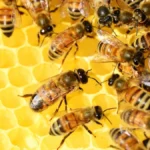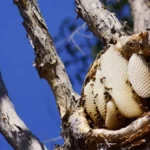In this article, we look at what a yellow jacket wasp is and if yellow jackets kill honeybees. Then we look at how yellow jackets and honeybees interact. Once we understand this interaction it is possible to protect our honeybees from yellow jackets. We can also find yellow jacket hives and deal with them if necessary.
What Is a Yellow Jacket?
Yellow jackets are semi-social wasps that nest in colonies. They are called yellow jackets because they are generally yellow and black striped insects. Yellow jackets collect nectar just like bees do, but unlike bees, they rely on hunting for their protein. Bees are vegetarian and eat pollen. Yellow jacket wasps are predators and eat flesh. This can be insects, small animals, and even fish flesh. There are many types of yellow jackets in the world, and in this article, we will specifically look at yellow jackets which will eat our bees.

Yellow Jackets and Honeybees
Yellow jackets and honeybees are enemies. Honeybees are eaten by certain types of yellow jackets. The yellow jacket wasp will catch the honeybee and either bite it to kill it or sting it. The yellow jacket then takes the bee carcass back to its nest and feeds the honeybee to young yellow jackets, who hatch. These yellow jackets then become hunters and catch more honeybees.
As a season progresses you can end up with a very large population of yellow jackets hunting your bees. This can have an adverse effect on your beehives.
The Yellow Jacket Life Cycle
Most yellow jackets have seasonal nests. In spring, a mated yellow jacket queen or queens emerge from some crevice or other sneaky place where she/they overwintered. A little nest is constructed out of plant fiber (looks like paper) and the first workers are reared. These yellow jackets then go out and forage killing insects and other meat sources and the queen can lay more eggs.
The nests can be constructed in the open hanging from a structure such as a branch or an eave or can be in the ground or a hollow in a tree or building.
The workers collect nectar and sugars from flowers, fruits, and in urban areas, beverage cans. The beverage can issue often causes problems when yellow jackets hijack people’s beverages.
The yellow jacket population explodes as the season progresses. In colder climates, at the end of the season, the yellow jacket colony succumbs to the cold. A few mated queens will go and hide in sneaky places, and the cycle reboots in spring.
With this understanding of the yellow jacket life cycle we can control the level of damage they cause to our bees.
Invasive Versus Indigenous Species of Yellow Jackets
An invasive species is a species that has been introduced to an area it is not indigenous to. In the USA, the German yellow jacket is an example of an invasive species. In the same region, the Eastern, Western, and Prairie yellow jackets are indigenous.
It must be highlighted at this point that honeybees are not indigenous to North America. Indigenous species of yellow jacket have little knowledge of what to do with honeybees but can learn as they are opportunists. German yellow jackets on the other hand come from a part of the world where honeybees actually make up a significant portion of their natural diet. Hence the invasive species of yellow jacket is somewhat ironically far more adapted to attack your honeybees.
Indigenous species are there for a reason, so we have to learn to live with them. Indigenous yellow jackets control many pest species. Invasive yellow jacket species should be destroyed. Identify the species of yellow jackets in nests near your hives and destroy any that are invasive. Learn to live with the indigenous ones, and control their numbers if necessary.
How Yellow Jackets Attack bees
Yellow jackets are after two things that bees have. Bees (protein) and honey (carbohydrates). Towards the end of the season, yellow jackets will swarm the entrance of a hive and can overwhelm a weaker hive. They will eat the bees, the brood, and the honey.
How to Protect Honeybees from Yellow Jackets
Prevention is Better than Cure
Nest Destruction
Yellow jacket nests can be found early in the season. If they are invasive, or species that are not threatened, the nests can be destroyed. Many professional yellow jacket hunters now exist who will remove the nests and extract venom for sale. Other creative souls now have the equipment to melt metals at night and cast ground yellow jacket nests. The influx of a gallon or so of molten metal into the yellow jacket nest reduces the population rapidly in a most satisfying way.
Trapping
Commercial yellow jacket traps exist which use bait and an odor lure to attract the yellow jackets into the trap. This will help to reduce the number of yellow jackets. Most studies suggest that a significant number of traps are needed to effectively reduce populations once yellow jackets have become established.
Poisoning
I am personally against using poison unless absolutely necessary. Should you so wish, there is one registered poisoning product available and you can find it here.
Strengthen Bee Defenses
Strong beehives have the ability to defend themselves against yellow jackets to a greater degree than weak hives. Keeping hives strong, and using the best genetics for your bees helps to ensure that the yellow jackets will have less impact on your bees.
Towards the end of the honey season, weaker hives may not be able to field enough guards to protect a big entrance. Using an entrance reducer is good practice at this point. It will help the bees to reduce the area they must guard, and as a result, a small number of guards can protect against both yellow jackets and robber bees from other beehives.
In my personal experience robber bees can cause more damage than yellow jackets. When bees start robbing hives, you end up with handfuls of dead bees as a result of fighting. These dead bees attract yellow jackets, ants, and other pests which will continue to drain the resources of the hives. Good hive management will help reduce all the negatives.
If this article helped you solve your yellow jacket problem, please share it.
Learn more about: How to Get Rid of Bumblebees Without Killing Them

Dr. Garth A. Cambray is a Canadian/South African entrepreneur and beekeeper with 28 years of experience in apiculture and specializes in adding value to honey. His Ph.D. research developed a new advanced continuous fermentation method for making mead that has resulted in a number of companies globally being able to access markets for mead. His company, Makana Meadery, exports honey mead to the USA where it is available to discerning connoisseurs. He has also developed technologies to commercially manufacture organic honey vinegar in Zambia for export globally. He holds a few patents globally in the ethanol industry and believes in technology and knowledge transfer for human development and environmental sustainability. One of his proudest achievements is the fact that the wind farm he started at one of his old apiary sites has essentially made his hometown carbon neutral.






